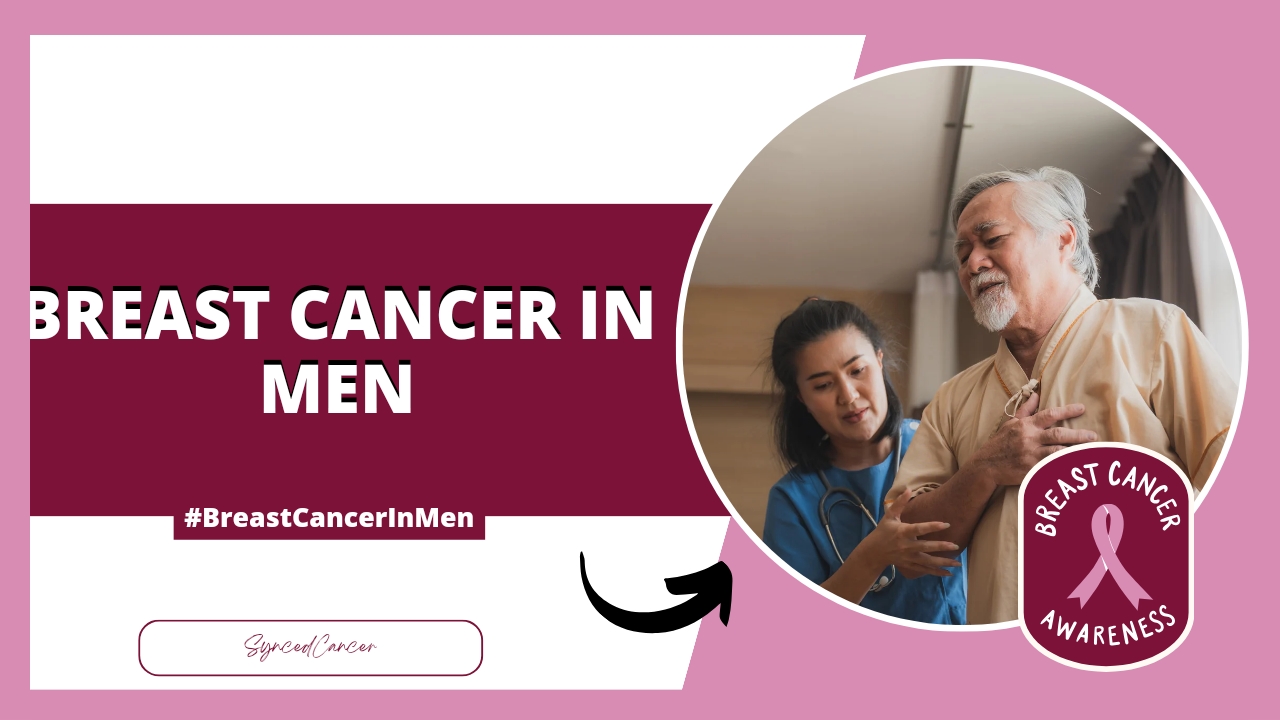Breast cancer is commonly associated with women, but it can affect men as well, although it is much rarer. Both men and women possess breasts comprised of fatty tissue, fibrous stroma, nipples, ducts (which transport milk to the nipples), and lobules (milk-producing glands). During puberty, hormonal changes in girls stimulate breast tissue growth, while in boys, hormonal influences limit breast growth, keeping their breast tissue smaller. The majority of breast cancers in men are ductal carcinomas, originating in the milk ducts. The American Cancer Society estimates that about 2,650 new cases of invasive breast cancer will be diagnosed in men in the United States in 2024. Understanding the causes and risk factors of breast cancer in men is crucial for early detection, treatment, and prevention.
Causes and risk factors of breast cancer in men
The exact cause of breast cancer in men is not fully understood, but like in women, it is believed to result from a combination of genetic, hormonal, and environmental factors.
- Genetic mutations: genetics plays a significant role in the development of breast cancer in men. Men who have close female relatives, such as mothers, sisters, or daughters, who have had breast cancer are at a higher risk. Additionally, men with a family history of mutations in the BRCA1 and BRCA2 genes are more likely to develop breast cancer. These genes are associated with a higher risk of breast cancer in both men and women, with mutations in these genes significantly increasing the risk.
- Hormonal factors: hormonal imbalances can contribute to the development of breast cancer in men. Although men have much lower levels of estrogen compared to women, an imbalance in hormone levels can still occur. Conditions that increase estrogen levels in men, such as Klinefelter syndrome, obesity, and liver disease, can raise the risk of breast cancer. Estrogen, even at low levels, can stimulate the growth of breast tissue, potentially leading to cancerous growth.
- Radiation exposure: exposure to radiation is a known risk factor for breast cancer in both men and women. Men who have received radiation therapy to the chest area for the treatment of other cancers, such as lymphoma, are at an increased risk of developing breast cancer. The radiation damages the DNA in the cells of the breast tissue, increasing the likelihood of cancerous growth.
- Lifestyle: Certain lifestyle factors can also influence the risk of breast cancer in men. Heavy alcohol consumption, smoking, and a sedentary lifestyle have been linked to an increased risk of various cancers, including breast cancer. These factors can weaken the immune system and cause oxidative stress in the body, making it more susceptible to cancerous mutations.
- Medical condition and treatment: medical conditions and treatments can raise the risk of breast cancer in men. Conditions such as gynecomastia (enlargement of breast tissue in men) and testicular disorders can increase the risk. Additionally, hormone therapies for prostate cancer that involve estrogen-like drugs can also elevate the risk of breast cancer in men.
- Age: age is a significant factor in the development of breast cancer in men. While breast cancer is more common in older women, men are also more likely to develop breast cancer as they age. The risk of breast cancer increases with age, with most cases diagnosed in men over the age of 60.

Types of male breast cancer
- Ductal Carcinoma In Situ (DCIS): Ductal Carcinoma In Situ (DCIS) is considered the earliest form of breast cancer. In DCIS, abnormal cells are found in the lining of a breast duct but have not spread outside the duct to surrounding tissues. While DCIS is not invasive, meaning it hasn’t spread beyond the ducts, it can progress to invasive cancer if left untreated. Treatment typically involves surgery to remove the abnormal cells, possibly followed by radiation therapy.
- Invasive Ductal Carcinoma (IDC): Invasive Ductal Carcinoma (IDC) is the most common type of breast cancer in men and women. In this type, cancer cells have spread beyond the ducts into surrounding breast tissue. IDC can also spread to other parts of the body if not treated. Treatment usually involves surgery to remove the tumor, followed by chemotherapy, radiation therapy, hormone therapy, or targeted therapy, depending on the specific characteristics of the cancer.
- Invasive Lobular Carcinoma (ILC): Invasive Lobular Carcinoma (ILC) is less common in men compared to women. This type of breast cancer starts in the lobules of the breast and can spread to nearby tissues. ILC often doesn’t form a distinct lump and may be harder to detect on imaging tests. Treatment for ILC typically involves surgery, followed by other therapies as needed.
- Paget’s Disease of the Nipple: Paget’s Disease of the Nipple is a rare form of breast cancer that affects the skin of the nipple and areola. It often appears as a scaly, red rash that may itch or burn. While Paget’s disease can occur in both men and women, it’s more commonly diagnosed in women. Treatment usually involves surgery to remove the affected nipple and areola, possibly followed by other therapies.
- Inflammatory Breast Cancer (IBC): Inflammatory Breast Cancer (IBC) is a rare and aggressive form of breast cancer that can occur in men but is more common in women. It often presents with symptoms such as redness, swelling, and warmth in the breast, resembling an infection. IBC tends to grow and spread quickly, requiring immediate and aggressive treatment, including chemotherapy, surgery, and radiation therapy.
Conclusion
Breast cancer in men is relatively rare but can be aggressive if not detected early. it’s essential to understand that men can develop various types of breast cancer, each with its own characteristics and treatment approaches. Understanding the causes and risk factors is crucial for early detection, treatment, and prevention. Men with a family history of breast cancer or known genetic mutations should undergo regular screenings and consider genetic counseling. Additionally, maintaining a healthy lifestyle, avoiding known risk factors like excessive alcohol consumption and radiation exposure, and being aware of changes in breast tissue can help reduce the risk of developing breast cancer in men. Early detection through regular breast exams and mammograms can greatly improve the prognosis and treatment outcomes for men with breast cancer.
REFERENCES
Breastcancer.org – https://www.breastcancer.org/types/male-breast-cancer?gad_source=1&gclid=Cj0KCQjw_-GxBhC1ARIsADGgDjtgZv376p-E_z9MJGGHqEt3-91v7Ia0bgeiGmK8NGx9Y3-T2w0Fs6saAtu4EALw_wcB
Assessed 5th May, 2024



What do you think?
It is nice to know your opinion. Leave a comment.